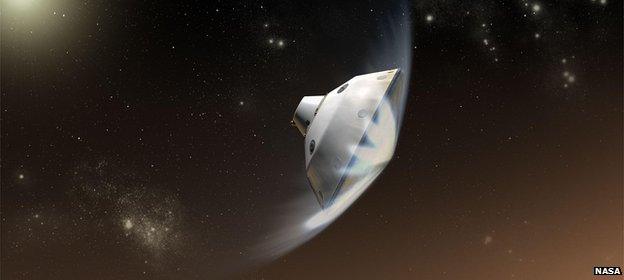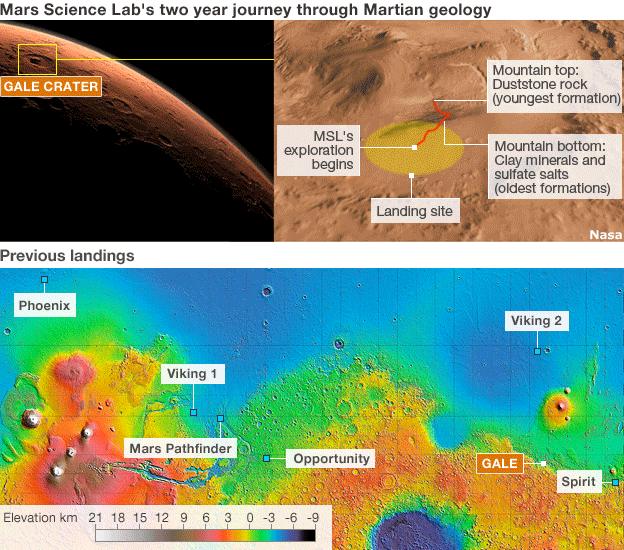‘Six minutes of terror’
- Published
- comments

The rover, tucked inside its protective shell, will hit the atmosphere at well over 12,000mph
Come August, we'll be right in the middle of the London Olympics - the greatest show on Earth. But you'll excuse me if I'm a little distracted towards what is sure to be the greatest show off Earth.
This will be the landing on Mars of Nasa's Curiosity rover, external, also known as the Mars Science Laboratory (MSL).
The Americans have despatched the biggest ever robotic rover to the Red Planet and it is due to touch down right in the middle of our sports spectacular.
"To give you the specific time so you can put it on your calendar - Monday 6 August, at six o'clock, 30 minutes and 13 seconds. British time," says Dr Charles Elachi, who heads the Jet Propulsion Laboratory, external in Pasadena, California, where the rover mission is being managed. Dr Elachi has been in London this week to enthuse about all things space but Mars in particular. On Monday evening he gave a lecture to the Royal Academy of Engineering, external.
Curiosity is the latest spacecraft to come out of the Nasa centre he has directed since 2001. Launched from Cape Canaveral last November, this 900kg behemoth is about half-way to its destination.
The $2.5bn robot is by far the most capable machine yet built to touch another world. It's packed with scientific instrumentation and even carries a laser to zap rocks to determine their chemistry.
Its great bulk means engineers have had to design a new type of landing mechanism for Curiosity. They call it the "skycrane". It's a kind of rocket-powered cradle that will hover over the Martian surface and gently lower the rover to the ground. But to get into this position, the mission first has to survive what Dr Elachi calls the "six minutes of terror" - the fiery entry into the Martian atmosphere and the herculean effort to slow the speed of the descent to zero with the aid of a heatshield, a parachute and those retrorockets on the skycrane.
"We'll be very nervous. Landing on another planet is not a walk in the park," the JPL director says.
"It's roughly a one-tonne rover. With the heatshield and the carrier, it will be about three tonnes of mass, coming in at a speed of 12,000mph and we have to land softly within less than six minutes.
"To give you an idea about the energy when you are coming at 12,000mph with that kind of mass - that's the equivalent of 25 high speed trains going at full speed. That's the amount of energy we have to dissipate in those six minutes so we can land softly on the surface.
"The accuracy with which we have to point, to be at the right angle and the right location, is equivalent to me being in Los Angeles and hitting a golf ball to St Andrews here in the UK, and the ball going straight in the cup.
"That's how accurate we have to have the navigation. And to make it a little bit more challenging, that cup is moving because Mars is moving at high speed."
If you haven't yet seen the animation of how this landing attempt is meant to proceed - then do watch it. If MSL pulls this one off, everyone in the JPL control room will be slapping their chests like Usain Bolt, and deservedly so.
Animation of Curiosity's journey to Mars and arrival on the Red Planet (Courtesy of Nasa)
There is a huge amount riding on this rover. President Obama has decided to slash Nasa's Mars budget: down from $587m this year to $360m next year - a 39% reduction. And unless Congress intervenes or the president has a change of heart, this funding profile is expected to remain in place for the duration of his second term (assuming he wins one in November).
It means that MSL could be the last American surface mission to the Red Planet for many years. It therefore adds a little extra tension to 6 August. But Dr Elachi remembers well the landing of Nasa's previous Mars rovers (Spirit and Opportunity, external) in 2004, and the expectation heaped on the agency back then.
"When we landed Spirit and Opportunity - that was shortly after the Columbia shuttle accident. And there was a lot of people who were saying, 'Nasa has lost its way; Nasa doesn't know how to do things'.
"So, you can imagine the pressure that was on us to show that we can still do bold things. There will be similar pressure with MSL.
"Everything depends on those six minutes. For sure, we're going to land. The question is will the media say we are heroes or bums the following day. It's black or white. There's no in between; either you land safely or you crash."
I can only imagine the disappointment at JPL on hearing the president's budget request. Dr Elachi conceded there was some, but then went on to explain how the Nasa Administrator Charles Bolden had visited the centre to emphasise that Mars exploration was still central to the agency's mission.
"We're going through a process of re-planning, and there's still a fair amount of money for that," he told me.
"Of course, we would have loved to do a 2016 and a 2018 mission jointly with Europe, but the budget situation means that looks unlikely now. Nasa [itself] is looking to a 2018 or 2020 opportunity."
And he added: "There will be a Mars exploration programme. The issue is not 'if', the issue is 'how much'. What capability will we be doing? Will we be doing orbiters or landers? And on what pace will we be doing them?"
Europe, as I indicated in a previous posting, has had to go back to the drawing board following the Americans' decision to pull out of their joint 2016 and 2018 missions.
We will find out next week what state the revised European plans are in when national delegations to the European Space Agency (Esa) meet to discuss the so-called ExoMars project. Esa officials have been discussing the possibility of carrying through the missions with the Russians as partners instead.

MSL Curiosity will try to land at the base of Gale Crater and then climb the mountain at its centre